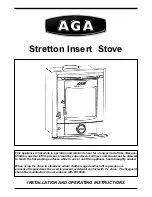
10
Fig.16
SLOW BURNING
To achieve slow burning when burning wood close
the secondary air slide and open a few millimetres
using the tool provided. Slow burning will cause the
window glass to blacken and should not be used for
a long period as it will leave sooty deposits in the
flueways. Opening the air slide will increase the
heat output and will clear the glass.
To obtain slow burning when burning coal, close the
secondary air fully and partially open the spin valve.
DE-ASHING
Never allow the ashpan to overfill as it will cause
damage to the grate. Empty the ashpan before
lighting. Always ensure that ashes have thoroughly
cooled before removing the ashpan. Open the fire
door and remove ashpan using the operating tool.
Close the fire door. When the ash is disposed of,
replace the empty ashpan. (See Fig.17) Do not
leave the fire unattended with the fire door open,
even for a minute.
WARNING - NEVER DISPOSE OF ASH WHEN
STOVE IS LIGHTING.
IMPORTANT - DAMAGE CAN OCCUR TO THE
FIREBED AND GRATE ASSEMBLY IF THE ASH-
PAN IS NOT CLEANED OUT DAILY AND BEFORE
EACH USE.
MAINTENANCE
CREOSOTE - Formation and Need for Removal
When some fuels are burned slowly, they produce
tar and other organic vapours, which combine with
expelled moisture to form creosote. The creosote
vapours condense in the relatively cool chimney flue
of a slow-burning fire. As a result, creosote residue
accumulates on the flue lining. When ignited cre-
osote makes an extremely hot fire.
CHIMNEY CLEANING
The chimney should be cleaned twice annually. The
chimney can be cleaned through the stove by
remove the fire lining and the baffle. The flue liner
should be cleaned in accordance with manufactur-
ers instructions. Always use a brush with plastic
bristles that is the correct size to reach all areas of
the flue.
REMEMBER COAL GASES ARE TOXIC
Fig.17
Summary of Contents for Stretton
Page 14: ...13 NOTES ...
Page 15: ...14 NOTES ...


































